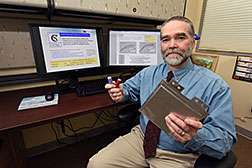Software diagnoses battery health and remaining life

High-performing batteries are capable of propelling vehicles for hundreds of miles, storing electricity for the electric grid or running powerful electronic devices for several hours. A significant gap exists in knowledge about battery health, however, especially in how specific battery chemistries respond to usage conditions and different environments. These factors influence the degradation mechanisms, while also creating uncertainty in capacity and power (remaining useful life).
Kevin Gering, a researcher at DOE's Idaho National Laboratory, has developed an advanced software diagnostic tool to assess batteries currently in use. Known as CellSage (or Cell's Age), this technology is able to characterize battery performance, diagnose the health of a battery in use, and predict how much longer it will be able to function in specific conditions and scenarios.
CellSage provides more realistic and accurate life cycle predictions by accounting for how diverse and variable real-world conditions drive battery aging. Its analyses include at least 10 specific environmental and operational parameters and more than 20 specific outputs.
To study a known Li-ion battery chemistry for electric-drive vehicle applications, the cycling protocol, geographic location and aspects of battery thermal management were analyzed by CellSage. Various geographic locations, battery chemistries, cycling protocols, and thermal management parameters can be selected to fine-tune the simulation and ensure the correct battery type is matched to the intended application. A rich collection of diagnostic information describes the predominant degradation mechanisms along a specified timeline.
To demonstrate CellSage, Gering used the software to predict geographic-dependent battery aging in hybrid electric vehicles (HEVs) operating for 10 years. One insight from the study was that the impact of daily thermal cycling on aging is significant—batteries should be kept cooler in summer and warmer in winter.
Provided by Oak Ridge National Laboratory



















